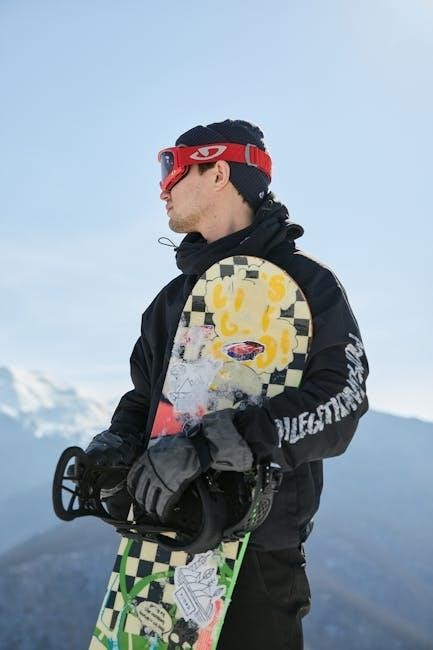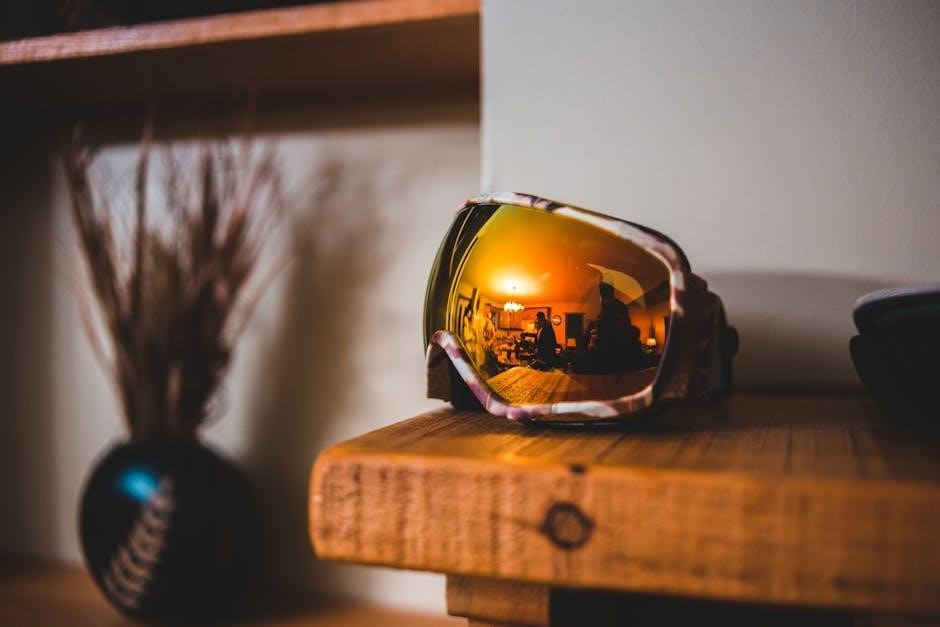Choosing the right ski goggle lens color is crucial for optimal visibility and performance on the slopes. Lens colors enhance contrast, reduce glare, and adapt to varying light conditions, ensuring clearer vision in snow, fog, or sunshine. Understanding the impact of tints, mirror coatings, and VLT (Visible Light Transmission) helps skiers select the perfect lens for their unique needs and skiing environment.
Why Lens Color Matters in Ski Goggles
Lens color in ski goggles plays a vital role in enhancing visibility and reducing glare, ensuring optimal performance on the slopes. Different tints are designed to adapt to specific lighting conditions, improving contrast and clarity. For instance, darker tints reduce glare in bright sunlight, while lighter tints enhance visibility in low-light or overcast conditions. The right lens color can minimize eye strain, improve reaction time, and boost overall skiing confidence by providing the best possible view of the terrain.
Overview of Popular Lens Colors and Their Purposes
Popular ski goggle lens colors include dark tints like gray and black, ideal for bright, sunny days by reducing glare. Amber and copper lenses enhance contrast in flat light, while rose and pink tints boost visibility in overcast conditions. Yellow lenses excel in low-light and foggy environments, offering high VLT for clarity. Mirror coatings further optimize performance by reflecting light and reducing glare, with options like blue, red, and silver mirroring available for specific lighting needs and aesthetic preferences.

Factors Influencing Lens Color Choice
Lens color selection depends on lighting conditions, weather, personal preference, skiing style, and VLT (Visible Light Transmission) to ensure optimal visibility and comfort on the slopes.
Lighting Conditions and Their Impact on Visibility
Lighting conditions significantly influence lens color choice for ski goggles. Bright sunlight requires dark tints or mirror coatings to reduce glare, while overcast skies benefit from lighter tints to enhance contrast. Flat light and fog demand high VLT lenses for maximum visibility. Ensuring the right lens for varying light ensures clearer vision, better depth perception, and improved safety on the slopes, adapting to the environment for optimal performance.
Weather and Environmental Factors
Weather and environmental factors play a key role in selecting ski goggle lens colors. Sunny conditions benefit from dark tints or mirror coatings to reduce glare, while snowy or foggy environments require high VLT lenses for clarity. Flat light and overcast skies call for lighter tints to enhance contrast. Environmental elements like snowfall or fog demand lenses that maximize light transmission, ensuring visibility and safety in varying conditions. Weather-adapted lenses enhance performance and comfort on the mountain.
Personal Preference and Skiing Style
Personal preference and skiing style significantly influence lens color choice. Skiers who prioritize contrast and clarity in low-light conditions often opt for yellow, amber, or rose tints. Those who ski in bright, sunny environments may prefer dark tints or mirror coatings for glare reduction. Racing or high-speed skiers might favor lenses with enhanced contrast, while all-mountain skiers may prefer versatile, medium-tint options. Ultimately, personal comfort and visibility needs guide the selection process, ensuring an optimal skiing experience.
Understanding VLT (Visible Light Transmission)
Visible Light Transmission (VLT) measures how much light passes through a goggle lens, ranging from 0% (opaque) to 100% (clear). Higher VLT (e.g., 80-100%) allows more light, ideal for low-light conditions like fog or overcast days. Lower VLT (e.g., 10-30%) reduces glare, suited for bright, sunny environments. VLT percentages guide lens selection based on lighting conditions, ensuring optimal visibility and comfort for skiers across varying environments and weather scenarios.
Best Lens Colors for Different Weather Conditions
Different weather demands specific lens colors. Sunny days call for dark tints with mirror coatings, while overcast days benefit from lighter tints for improved contrast. Flat light requires enhanced visibility, and snowfall or fog necessitates high VLT options for clarity.
Bright and Sunny Days: Dark Tints and Mirror Coatings
For bright, sunny conditions, dark-tinted lenses with mirror coatings are ideal. These reduce glare from snow and sunlight, enhancing visibility. Dark grey, brown, or dark rose lenses block intense light, while mirror coatings reflect sunlight, reducing eye strain. These options are perfect for high-altitude skiing or sunny terrains, providing superior clarity and contrast. They also help maintain true color perception, ensuring a crisp view of the slopes ahead.
Overcast and Cloudy Days: Lighter Tints for Contrast
On overcast or cloudy days, lighter-tinted lenses are essential for maintaining visibility and contrast. Colors like yellow, amber, or rose enhance clarity by increasing contrast in low-light conditions. These tints help skiers distinguish terrain features more easily, even when the light is diffuse. They also reduce eye strain caused by flat light, making them ideal for cloudy or snowy environments where definition is challenging. Lighter tints ensure better performance in subdued lighting without sacrificing visual acuity.
Flat Light and Low Visibility: Enhancing Contrast
Flat light and low visibility conditions, such as heavy snow or fog, require lenses that enhance contrast to improve definition. Yellow, amber, or rose-tinted lenses are ideal as they boost contrast, making terrain features more distinct. These tints reduce eye strain by adding warmth and clarity to the scene. They also help skiers perceive depth and texture, which is critical in challenging visibility. By enhancing visual acuity, these lenses ensure better performance and safety in adverse weather.
Snowfall and Fog: High VLT Lenses for Maximum Visibility
In snowfall or fog, high VLT (Visible Light Transmission) lenses are essential for maintaining clarity and visibility. Yellow, amber, or clear lenses with VLT rates of 43-80% allow maximum light entry, enhancing vision in low-light conditions. These tints reduce glare from snowfall while preserving contrast, making it easier to navigate through foggy or snowy environments. High VLT lenses ensure better safety and performance, even when visibility is severely reduced by weather conditions.

Universal Lens Colors for Versatility
Medium copper, rose, and brown tints offer balanced contrast and glare reduction, making them versatile for varying conditions. Clear lenses are ideal for low-light scenarios.
Medium Copper, Rose, and Brown Tints
Medium copper, rose, and brown tints are versatile, offering balanced contrast and glare reduction. These colors enhance depth perception and adapt well to both sunny and overcast conditions. Ideal for skiers seeking a middle ground, they provide clear visibility without heavy mirror coatings, making them a practical choice for varied environments and lighting situations.
Clear Lenses for Low-Light Conditions
Clear lenses are ideal for low-light conditions, offering maximum light transmission to enhance visibility in dim environments. With high VLT, they allow more light to enter, reducing eye strain during overcast or foggy days. Perfect for early mornings or late evenings, clear lenses ensure optimal clarity without altering color perception, making them a reliable choice for skiers navigating challenging lighting scenarios.

Mirror Coatings and Their Benefits
Mirror coatings reduce glare and block specific light wavelengths, enhancing visibility. They offer UV protection and minimize eye strain, improving optical clarity in bright conditions.
What Are Mirror Coatings?
Mirror coatings are thin, reflective layers applied to goggle lenses. They reduce glare by blocking specific light wavelengths and enhance UV protection. These coatings improve visual clarity in bright conditions, minimizing eye strain. Available in various colors like silver, gold, and blue, they not only enhance performance but also offer a stylish appearance. Mirror coatings are particularly beneficial in sunny environments, optimizing light transmission for clearer vision.
When to Use Mirror Coatings
Mirror coatings are ideal for bright, sunny conditions where glare is a challenge. They are beneficial on snow-covered slopes, as they reduce reflective light. In high-altitude skiing, where UV exposure is intense, mirror coatings provide additional protection. They are also useful in environments with excessive light reflection, such as ice or water. However, they may not be the best choice for low-light conditions, where maximizing visibility is more critical than reducing glare.
Popular Mirror Colors and Their Effects
Popular mirror coatings include blue, red, and platinum, each offering unique benefits. Blue mirrors reduce glare and enhance contrast in bright conditions, while red or pink mirrors brighten surroundings and improve visibility in flat light. Platinum mirrors provide neutral light reduction and a stylish appearance. Gold mirrors enhance warm tones, and rose mirrors improve clarity in low-light settings. Each color is tailored to specific lighting conditions, helping skiers optimize their vision on the slopes.

How to Choose the Right Lens for Your Needs
Consider lighting, weather, and personal skiing style when selecting a lens. Match your environment, budget, and preference for contrast or light transmission to ensure optimal performance.
Considering Your Budget and Skiing Frequency
Assess your skiing frequency and budget to choose lenses wisely. Occasional skiers may opt for versatile, cost-effective options, while frequent skiers can invest in interchangeable lenses for varying conditions. Budget-friendly goggles often include standard tints, while higher-end models offer advanced features like mirror coatings or high VLT. Balance your spending based on how often you ski and the environments you typically encounter to maximize value and performance.
Matching Lens Color to Your Skiing Environment
Match your ski goggle lens color to your skiing environment for optimal performance. In bright, sunny conditions, dark tints like gray or black reduce glare. For cloudy or overcast days, medium tints such as rose or amber enhance contrast. In flat light or foggy conditions, high VLT lenses improve visibility. Ensuring your lens color aligns with your surroundings maximizes clarity and safety on the slopes.
Final Tips for Selecting the Best Lens
When selecting the best lens, consider your skiing environment, personal preferences, and budget. Test lenses in different conditions to ensure optimal visibility. Prioritize high VLT for low-light settings and mirror coatings for glare reduction in bright conditions. Avoid compromising on quality for cost, as clear vision is essential for safety. Choose lenses with good contrast enhancement and durability, ensuring they align with your skiing style and terrain preferences for the best experience on the slopes.
